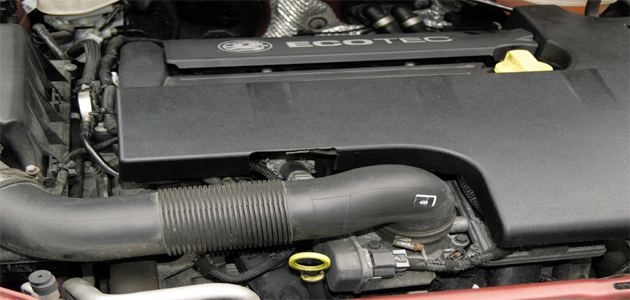
Andy Horwat of Engine Tuning & Diagnostics shares an unusual issue he encountered with a customer’s Vectra.
The customer in question was a new one to my workshop, and he had called to discuss a problem with his Vauxhall Vectra. The vehicle was a ’57 plate, 2.2 direct petrol injection model which was experiencing an intermittent loss of power.
Loss of power
The issue first occurred when he was driving along a busy dual-carriageway at around 70mph, and out of nowhere the car suddenly lost power. Luckily, he was able to coast into a nearby layby. He restarted the car and managed to drive off again with no problem. A week later, his wife took the car for a spin, but while driving up a hill she also encountered the same problem.
The owner immediately took the car to his local garage, who claimed/assumed that there was an electrical problem, but were unable to pin-point what or where it was. In the quest to find someone who could diagnose the problem, this car eventually ended up in front of me and, upon hearing the evidence, the first thing that came to mind was whether any fault codes might have been stored.
I discovered one code present – rail pressure sensor – and this sounded to me like a good start. I began with the usual basic check under the bonnet and things appeared as they should, so I then connected the scope to the rail pressure sensor (a 5V device). Under full throttle, I would expect a reading in excess of 4V and that appeared to be the case, however the fault code that was flagged was of great interest. I then allowed the engine to idle and a closer look at what was actually happening became clearer.
The normal waveform that you find when testing a common rail diesel would show a steady rise, yet when the engine is allowed to idle, the voltage drops 1.2V to allow the engine to settle. With this particular vehicle, however, something interesting began to happen as I began to see drop outs every few seconds and now and again – when the engine RPM was raised – the pressure sensor appeared faulty.
Although I had clear evidence of the one fault, after thinking through the symptoms, I was convinced there were more faults than that.
Tested under load
I decided the first course of action was to replace the pressure sensor and recheck the system. Once the sensor was fitted, the scope screen showed that the drops and noise had disappeared. Semi-satisfied, we took the car for a test, and the first engine response certainly appeared to be much better and smoother.
To be sure of this, the car was then tested under a greater load, but it was discovered that in this situation the car again lost power and slipped into LOS on return to the workshop. My attention was now drawn to the high pressure pump, but I wasn’t going to condemn it until I had a handle on some more facts!
My first port of call was to check the low pressure supply, and I recorded readings of around 3 bar which is what I was expecting. The second check was the duty cycle on the pressure regulator. I found figures of 18% on idle to around 90% upwards, however, a static test in the workshop may not reveal the maximum reading.
This device works in conjunction with the fuel pressure regulator; the maximum RPM is around 4,000, so maximum duty cycle may not be achieved. It was put to the test through the serial tool on the test drive and appeared to reach 60-65% and holding, so there was no reason to believe that the regulator was at fault. From this I found the culprit was the high pressure pump.
Finding a replacement high pressure pump, however, seemed more of a challenge than discovering the actual problem. In my home town of Swindon, there are a number of national parts suppliers, all of whom I contact on a regular basis, yet in this case every single distributor told me the same thing: “We have stopped supplying this part.”
After conversations with the branch managers of each of these motor factors, it was then decided that the only place I would be able to get this part was from the main dealer, as the component in question was no longer being stocked due to its high failure rate. Hearing I have no choice but to visit a main dealer never sits well, but on this occasion I didn’t have much say in the matter. I informed the customer of the issues found, and that he could be faced with a high cost of replacement.
I got in touch with the nearest Vauxhall dealer, and the quote I was returned confirmed that this part was not going to come cheap, but I also appreciate that this is what you’re faced with when an aftermarket supplier can’t meet your demand. By this stage my curiosity had piqued: why was this particular part restricted?

The Vectra engine
The gentleman on the phone was good enough to admit there had been issues in the past of high failure rates involving this part, and that there had been a national recall regarding the fuel pressure regulators. The car was checked and it had been replaced previously meaning the problem had been solved temporarily, but the CAUSE was far from being resolved.
Eventually a replacement pump was delivered and the component was replaced and tested, leaving us with a very satisfied customer.
The plot thickens
This particular story hadn’t ended there, though. I like to think of myself as a perfectionist and someone who starts and finishes a job with all results positive. I therefore decided to do some research into this ‘recall’ issue, and the high failure rate of these high pressure pumps.
What I managed to uncover really opened up a can of worms – so high was the failure rate that the car actually managed to make it on to an episode of Watchdog. Vauxhall claims that the problem with the pump has now been solved, but also stated there was still an issue with the regulator.
My research has taken me to some of my own interesting conclusions, all of which will follow in a future troubleshooter column!









